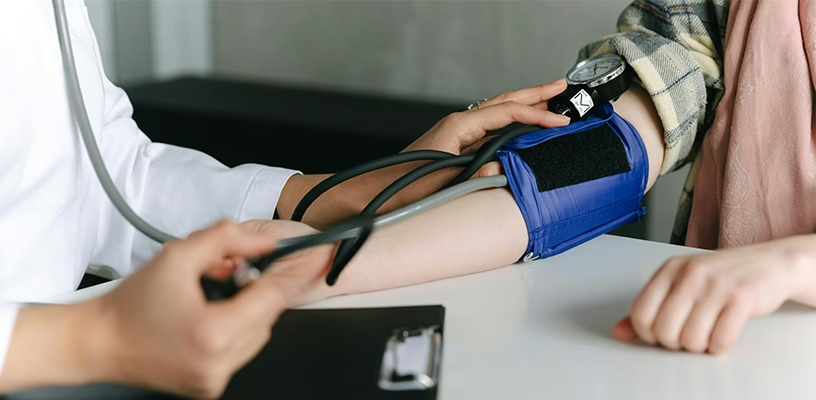What Is Preeclampsia? Signs and Symptoms, Treatment Options, and More
Pregnancy is a time of exciting changes, but for some women, those changes can lead to serious health complications, such as preeclampsia.

Preeclampsia is a severe disorder marked by high blood pressure (hypertension) and, in many but not all cases, large amounts of protein in the urine (proteinuria). This condition is exclusive to pregnancy and the postpartum period, and has a 5–8% chance of affecting you and your baby, even after you give birth. 1
Although that percentage may seem small, it’s actually quite significant, and this is a condition that all expecting parents should be aware of—including the associated risks, symptoms, and management strategies. Read on to learn more about preeclampsia.
What is preeclampsia?
If you develop a sudden onset of high blood pressure (140/90 mmHg or higher) after the 20th week of pregnancy, your healthcare providers may diagnose you with preeclampsia. Sometimes, this condition is also known as pregnancy-induced hypertension (PIH) or toxemia.
If you have a mild case, you might not notice that anything is wrong at all. However, severe cases of preeclampsia can endanger you and your baby’s safety. 2
What are the symptoms of preeclampsia?
Your healthcare provider will screen for preeclampsia during your prenatal visits, but it’s still important for you to be aware of what signs to look out for.
There are two types: obvious signs that you can watch for on your own, and symptoms that require testing.
Preeclampsia signs you can watch for yourself
Keep an eye out for any of the following: 3 4
- Headaches and vision changes: You may experience lightheadedness or a dull, throbbing headache that doesn’t go away, accompanied by sensitivity to light. You may also notice double vision, temporary blindness, flashes of light, spots, or blurry vision during your pregnancy if you have preeclampsia.
- Swelling: You may experience sudden or severe swelling around your eyes, face, and hands. Some swelling is normal during pregnancy, but it’s important to see a doctor if this happens, just in case.
- Rapid weight gain: Gaining weight is also very normal when you’re pregnant, but it can be a sign of preeclampsia if you gain more than three to five pounds in one week.
- Nausea and vomiting: Morning sickness (pregnancy-related nausea) usually fades after the first trimester. If it persists after the midpoint of your pregnancy, get checked out.
- Pain in your right side: You may feel pain in your right shoulder or in your upper abdomen (under your right ribs). Note that rib pain during pregnancy can have other causes, so always talk to your doctor about your symptoms.
- Decreased urine output: Preeclampsia can make you pee less than usual.
- Shortness of breath: In severe cases, preeclampsia can also make breathing difficult due to fluid buildup in your lungs (pulmonary edema).
- Changes in reflexes: Your reflexes may become overactive or exaggerated (hyperreflexia)—think of a literal knee-jerk reaction.
Tell your doctor right away if you notice that your baby has stopped kicking or is otherwise significantly less active than usual. This can happen for various reasons (preeclampsia is just one of them), and it always merits an immediate evaluation to make sure nothing is seriously wrong.
Preeclampsia signs that require testing
Here are a few other symptoms of preeclampsia that may show up on a medical test, but that you won’t be able to watch for on your own:
- High blood pressure: You can test yourself at home using a blood pressure monitor to see if you have a reading of 140/90 mmHg or higher. 4
- Proteinuria: As mentioned, this refers to excessive protein in your urine, which indicates kidney damage. You can test for this with an over-the-counter urine dipstick kit.
- Low platelet count: Testing for this requires a visit to your doctor, who can perform a blood test to measure your platelets (blood-clotting cell fragments).
Again, you don’t need to stress yourself out by testing for those symptoms yourself—your doctor will watch out for the telltale signs of preeclampsia and take action if they get concerned.
What are the risk factors for preeclampsia?
While preeclampsia can develop in anyone, you’re more at risk if this is your first pregnancy. In fact, about two-thirds of preeclampsia cases affect first-time moms. You’re also at risk if you were a mom before and waited more than ten years between pregnancies. 4
Additionally, you’re more likely to develop preeclampsia if you have certain preexisting conditions like kidney disease (renal disease), diabetes, hypertension, obesity—meaning you have a body mass index (BMI) over 30—and autoimmune diseases, such as lupus or antiphospholipid syndrome (APS). 5
A history of preeclampsia in a previous pregnancy elevates your risk of developing it again. Note that the earlier preeclampsia occurred during your first pregnancy, the more severe it will tend to be in your next one. 6 You’re also more at risk if preeclampsia runs in your history (e.g., you had a mother or sister who had it). 7
Other risk factors for preeclampsia
Other risk factors include: 7 8
- Carrying multiples: Your risk increases when you’re carrying twins, triplets, etc.
- Advanced maternal age: Being over 35 years old is a risk factor.
- Fertility treatments: Pregnancies conceived through in vitro fertilization (IVF) may have a slightly higher risk.
- Race and ethnicity: Black women are 60% more likely to be affected by preeclampsia than their white counterparts (it isn’t entirely clear why this is, and it may be due to an intersection of socioeconomic and biological factors).
If you’re at high risk of developing preeclampsia, the US Preventive Services Task Force (USPSTF), the Society for Maternal-Fetal Medicine (SMFM), and the American College of Obstetricians and Gynecologists (ACOG) recommend a low-dose aspirin (81 mg) starting between 12 and 28 weeks of pregnancy. This dosage may prevent or delay the onset of pre-eclampsia. 9 10
However, before prophylactically taking aspirin like this, discuss it with your doctor to check if it’s right for you.
How preeclampsia can affect you and your baby
Again, preeclampsia is a serious condition. It causes over 70,000 maternal deaths and 500,000 fetal deaths every year around the world. 11.
Risks for mothers
If you have preeclampsia, you may experience damage to your liver, kidneys, brain, and other organs. More severe cases can also lead to seizures (eclampsia). 12
In addition, preeclampsia can put you at a higher risk of HELLP syndrome (that stands for “hemolysis, elevated liver enzymes, and low platelet count”), which can further affect your blood pressure, liver, and blood-clotting ability.
In some cases, preeclampsia can cause your placenta to detach from the uterus, resulting in heavy vaginal bleeding and many other serious accompanying symptoms, including some that are potentially fatal. 13
Preeclampsia can affect you in the postpartum period, too
In rare cases, preeclampsia can develop between 48 hours and six weeks after you deliver your baby. If you’ve had preeclampsia, your future health may also be compromised as you’re now three to four times more likely to develop chronic high blood pressure and twice as likely to develop heart disease—leading to heart attacks—and stroke.
Risk for infants
Preeclampsia is a leading cause of premature birth, resulting in approximately 20% of all early deliveries. If your baby is a preemie (especially if she was born before week 32 of your pregnancy), she’ll likely have a low birth weight and will be more prone to respiratory problems, feeding difficulties, learning disabilities, and other complications. 14
Your baby also may have a slowed growth rate, as preeclampsia reduces the amount of nutrients and oxygen you pass to your baby. 15 If your placenta detaches entirely (placental abruption), that can result in fetal brain damage and death, as well as maternal complications and death. 16
How doctors screen for preeclampsia
As you’re probably gathering, preeclampsia is a big deal. Fortunately, because of this, doctors are vigilant about checking for it during routine prenatal visits.
If your doctor thinks there’s a chance you’re developing it, they may order any of these tests: 17
- Blood pressure tests: Regular blood pressure monitoring can confirm if you’ve developed a prolonged elevated high blood pressure.
- Urine protein analysis: Sometimes, this might involve providing a single urine sample, but your doctor may also provide you with a container to collect your urine over a 24-hour period for a more accurate test of your protein levels.
- Blood tests: Blood tests can evaluate how well your kidney and liver are functioning, as well as your platelet count.
- Fetal monitoring: Your doctor may use a pregnancy ultrasound and a nonstress test to check your baby’s heart rate and assess her growth and overall well-being.
Keep in mind that a single elevated blood pressure reading doesn’t necessarily mean that you have preeclampsia. The same applies to the presence of protein in your urine. Your doctor will look for a pattern of symptoms and evaluate your individual risk factors before making a diagnosis.
Managing and treating preeclampsia
If you have preeclampsia, your treatment options depend on the severity of your condition and how far along you are in your pregnancy. In a significant number of cases, doctors recommend inducing labor (or performing a C-section) to wrap the at-risk pregnancy up early. 18
With that said, there’s more than one way of treating preeclampsia, and your options depend on whether your case is mild or severe.
For mild preeclampsia, your doctors will perform weekly checks to test your blood pressure, urine, and fetal monitoring. Your doctors may also advise you against any strenuous activity and recommend a new diet with a reduced salt intake (though you should be maintaining a healthy pregnancy diet from the start).
For severe preeclampsia, as mentioned, there’s a good chance your doctors will recommend labor induction. They may also prescribe:
- Antihypertensive medications to lower your blood pressure
- Magnesium sulfate to prevent seizures
- Corticosteroids to boost your platelet count, improve your liver function and develop your baby’s lungs more quickly (in case you need to deliver her early) 17
How to protect your long-term health with postpartum care
After your delivery, it’s important to remain vigilant for signs of postpartum preeclampsia. As mentioned, this condition can develop up to six weeks after childbirth.
Symptoms are similar to those experienced during “ordinary” preeclampsia, so keep an eye out for postpartum swelling, high blood pressure, headaches, vision changes, and so on. 19
How lifestyle changes can protect you against postpartum preeclampsia
Fortunately, you can guard yourself against postpartum preeclampsia by practicing good habits that will benefit your health in other ways, too.
Focus on maintaining a healthy weight through diet and exercise. Eat balanced servings of fruits, vegetables, whole grains, and lean protein, while cutting back on processed foods, sugary drinks, and saturated fats. The World Health Organization also recommends at least 150 minutes of moderate-intensity aerobic exercise like swimming and running every week (30-minute sessions, five times a week). 20
Follow your doctor’s advice to manage your blood pressure and cholesterol levels. Avoid tobacco and alcohol, as they can increase your risk of cardiovascular disease.
How to prepare for future pregnancies when you’ve had preeclampsia
As mentioned, you’re seven times more likely to develop preeclampsia in a later pregnancy if you’ve previously experienced it. For that reason, you need to create a plan with your healthcare providers to monitor and manage your condition. This may include:
- Preconception counseling: Meet with your doctor before conceiving to discuss your risk and form a “battle plan” to safeguard your health.
- Early prenatal care: Start prenatal care as soon as you know you’re pregnant.
- Low-dose aspirin: You may want to take low-dose aspirin, as recommended by your doctor.
- Close monitoring: Increase your chances of detecting preeclampsia early by regularly screening your health throughout your pregnancy, such as through blood pressure checks, urine tests, and fetal monitoring.
Dealing with conditions like preeclampsia can be difficult emotionally, not just physically, so lean on your partner, family, and friends as much as you need. You can also consider reaching out to women in your community (or joining online support groups) to ask for advice from other mothers who’ve been there and done that.
Final thoughts
Getting diagnosed with preeclampsia can be frightening, but you’re not alone. Your healthcare providers are there to help, and you should always share any concerns you have with them and follow their advice.
By staying informed, you can empower yourself to manage your preeclampsia and safeguard your health and the well-being of your baby.
Article Sources
- Preeclampsia.org. "What Is Preeclampsia" Retrieved April 30, 2025.
- Harvard Health Publishing. "Preeclampsia and eclampsia" Retrieved April 30, 2025.
- Johns Hopkins Medicine. "Preeclampsia" Retrieved April 30, 2025.
- Mount Sinai. "Preeclampsia" Retrieved April 30, 2025.
- National Health, Lung, and Blood Institute. "Antiphospholipid Syndrome (APS)" Retrieved April 30, 2025.
- Healthline. "Preeclampsia: Second Pregnancy Risks" Retrieved April 30, 2025.
- American College of Obstetricians and Gynecologists. "Preeclampsia and Pregnancy" Retrieved April 30, 2025.
- Sanford Health. "What causes preeclampsia?" Retrieved April 30, 2025.
- U.S. Preventive Services Task Force. "Aspirin Use to Prevent Preeclampsia and Related Morbidity and Mortality: Preventive Medication" Retrieved April 30, 2025.
- American College of Obstetricians and Gynecologists. "Low-Dose Aspirin Use for the Prevention of Preeclampsia and Related Morbidity and Mortality" Retrieved April 30, 2025.
- U.S. Centers for Disease Control and Prevention. "Preeclampsia, Genomics and Public Health" Retrieved April 30, 2025.
- Eunice Kennedy Shriver National Institute of Child Health and Human Development. "What are the risks of preeclampsia & eclampsia to the mother?" Retrieved April 30, 2025.
- StatPearls. "Placental Abruption" Retrieved April 30, 2025.
- U.S. Centers for Disease Control and Prevention. "Preterm Birth" Retrieved April 30, 2025.
- National Health Service. "Complications" Retrieved April 30, 2025.
- Better Health. "Placental abruption" Retrieved April 30, 2025.
- UCHealth. "Preeclampsia" Retrieved April 30, 2025.
- National Health Service. "Treatment" Retrieved April 30, 2025.
- Preeclampsia.org. "Postpartum Preeclampsia" Retrieved April 30, 2025.
- World Health Organization. "Physical activity" Retrieved April 30, 2025.







